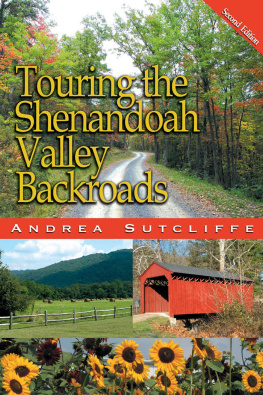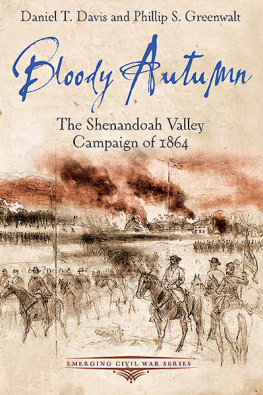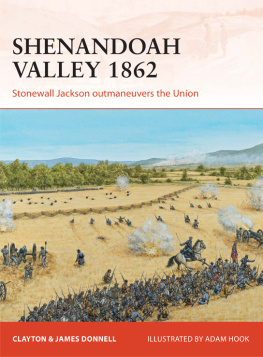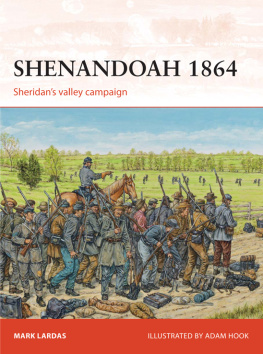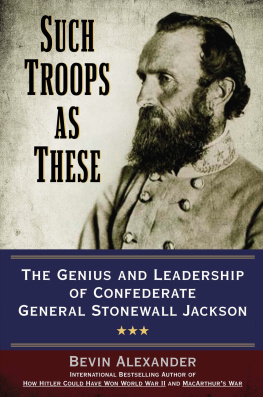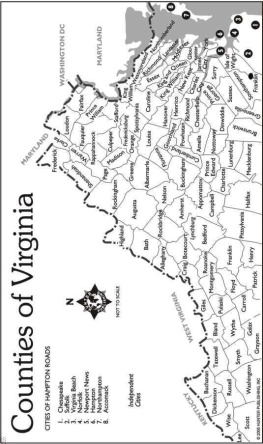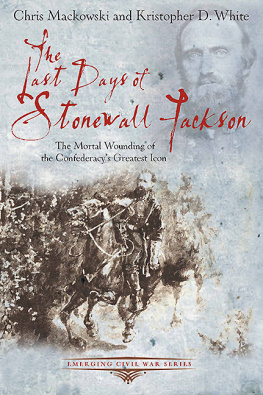S TONEWALL
J ACKSONS 1862
V ALLEY C AMPAIGN
S TONEWALL
J ACKSONS 1862
V ALLEY C AMPAIGN

W AR C OMES TO THE H OMEFRONT
J ONATHAN A. N OYALAS
Series Editor Douglas Bostick

Published by The History Press
Charleston, SC 29403
www.historypress.net
Copyright 2010 by Jonathan A. Noyalas
All rights reserved
Cover image: Shenandoah Autumn by Mort Knstler, 2003 Mort Knstler, Inc., www.mkunstler.com.
First published 2010
e-book edition 2011
ISBN 978.1.61423.040.3
Noyalas, Jonathan A.
Stonewall Jacksons 1862 Valley Campaign : war comes to the homefront / Jonathan A. Noyalas.
p. cm.
Includes bibliographical references and index.
print edition: ISBN 978-1-59629-793-7
1. Shenandoah Valley Campaign, 1862. 2. Jackson, Stonewall, 1824-1863--Military
leadership. I. Title.
E473.7.N69 2010
973.732--dc22
2010039246
Notice: The information in this book is true and complete to the best of our knowledge. It is offered without guarantee on the part of the author or The History Press. The author and
The History Press disclaim all liability in connection with the use of this book.
All rights reserved. No part of this book may be reproduced or transmitted in any form
whatsoever without prior written permission from the publisher except in the case of brief
quotations embodied in critical articles and reviews.
Dedicated to my wife Brandywords can never express my love.
C ONTENTS
P REFACE
From the time the Civil Wars guns fell silent in the spring of 1865 until the present century, each generationperhaps taking heed of Voltaires advice that each generation needs to rewrite history because each one ponders new historical questionshas chronicled the Civil Wars drama. While future generations will undoubtedly recast the conflict in their own terms, as the Civil Wars 150th anniversary approaches historians today also have a great chance to educate the wider public about our nations epic struggle and its role as the pivotal, defining moment of our American republic. This book is written with that intention in mind.
Since the spring of 1862, Stonewall Jacksons Valley Campaign has captivated people around the world. The campaigns popularity has charmed historians for decades. Scholars such as James I. Robertson Jr.who happened to be my thesis advisor during my graduate school days at Virginia TechRobert Tanner, Peter Cozzens, Robert K. Krick, Gary Ecelbarger and Brandon H. Beck (my undergraduate mentor) have investigated various aspects of Jacksons life and his famed campaign in the Shenandoah that played a crucial role in the Confederacys military operations during the first half of 1862. This volumeintended to bring Jacksons Valley Campaign to life in a more succinct fashion for individuals with varying interests in the Civil Warbuilds on current scholarship, new research and new historical perspectives to offer some fresh insights into one of the Civil Wars most storied campaigns: namely, how the campaign affected the valleys civilians, particularly Unionist sympathizers and African Americans; the role of art and other tools of historical memory in helping define the legacies of men such as Stonewall Jackson and General James Shields; and how, in defeat, Union veterans sometimes reflected positively on their involvement in Jacksons Valley Campaign.
In crafting this succinct volume, I have relied heavily on the primary accounts left by participants, some of which are in private collections and appear in this volume for the first time. Additionally, newspaper accounts and testimony in the Southern Claims Commission at the National Archives have aided me in crafting the campaigns story from the perspective of Shenandoah Valley civilians whose peaceful existence was interrupted by battles and military occupation.
Any book project is a tremendous undertaking and would not be possible without a supporting cast. The people I recognize have in some way contributed to this project but are in no way at fault for any of its errors: Dr. Brandon H. Beck, director emeritus of the McCormick Civil War Institute at Shenandoah University and the man who put Winchesters Civil War history on the map for a wider audience, has been a great friend and supporter of this project; Rebecca Ebert and the staff at the Stewart Bell Jr. Archives, Handley Regional Library in Winchester, Virginia, who always assist me on my visits to that repository and who have been active supporters of my publication projects; Dr. Irvin and Mrs. Nancy Hess, who always welcome my tours of Cross Keys and the Widow Pence Farm with enthusiasm; Elizabeth McClung, executive director of the Belle Grove House in Middletown, Virginia; Nicholas P. Picerno, my dear friend and tireless advocate of battlefield preservation in the valley and who opened up his collections once again for my use; the staff at the Valentine Richmond History Center, especially Meghan Holder, who assisted me with William Washingtons painting Stonewall Jackson Entering Winchester; the staff of the R.W. Norton Gallery, especially Jerry Bloomer, for granting permission to reproduce L.M.D. Guillaumes painting Stonewall Jackson at Winchester; Patricia Stringfellow and the Jasper County Public Library in Rensselaer, Indiana; the staff at the Swem Library, College of William and Mary; the Virginia Historical Society, especially Dr. E. Lee Shepard; Dr. Joseph Whitehorne, my friend and colleague in the history department at Lord Fairfax Community College who shared his knowledge about the skirmish at Middletown in May 1862; and Karen Wisecarver, the interlibrary loan specialist at my institution, Lord Fairfax Community College, who went above and beyond the call of duty in tracking down multiple, obscure sources to support my research. Last but certainly not least, I would like to thank two people in my life who provide support that cannot be quantified: my son, Alexander Philip, who is a constant source of inspiration and joy, and my wife, Brandy, the love of my life and a fine historian and teacher, whose research assistance, advice and loving support have been invaluable.
I NTRODUCTION
Several months after the Civil War ended, John Trowbridgea noted author of the timetoured Virginias battlefields. As he rode in a train in Virginias Shenandoah Valley, he witnessed wars devastating impact firsthand. We passed through a region of country stamped all over by the devastating hell of war. For miles not a fence or cultivated field was visible. Although each engagement had various consequences in the wars larger scheme, no campaign dominates the American imagination more than Stonewall Jacksons 1862 Valley Campaign. Throughout the spring of 1862, Jacksons army marched nearly seven hundred miles, won five major battles and inspired an infant Confederate nation.
Although not as large as the 1864 Valley Campaign, which brought tremendous destruction to the area and cleared the valley of any substantial Confederate force, Jacksons 1862 Valley Campaign occurred at a time when the Confederacy was suffering setbacks on every other frontForts Henry and Donelson were lost, Confederates were defeated at Shiloh, New Orleans was occupied by General Benjamin F. Butler, there was failure in Arkansas and General George B. McClellans massive Army of the Potomac threatened Richmond. Jacksons campaign brought hope and inspiration to everyone in the Confederacysoldiers and civilians alike. His achievements in the valley also aided the efforts of General Joseph E. Johnston to defend the Confederate capital by creating anxiety among war planners in Washington, D.C., who diverted troops away from McClellan and to the valley to deal with Jackson.
Next page


